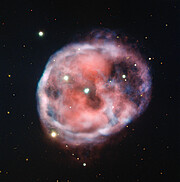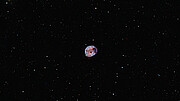Pressemitteilung
Sterne und Schädel: Neues Bild der ESO enthüllt unheimlichen Nebel
30. Oktober 2020
Dieser ätherische Überrest eines längst toten Sterns, eingebettet im Bauch des Wals, hat eine verblüffende Ähnlichkeit mit einem durch den Raum schwebenden Schädel. Der unheimliche Totenkopfnebel, der mit dem Very Large Telescope (VLT) der ESO in verblüffender Detailgenauigkeit aufgenommen wurde, wird in diesem neuen Bild in wunderschönen blutroten Farben dargestellt. Dieser planetarische Nebel ist der erste, von dem bekannt ist, dass er mit einem Paar eng verbundener Sterne assoziiert ist, die von einem dritten äußeren Stern umkreist werden.
Der auch als NGC 246 bekannte Totenkopfnebel liegt etwa 1600 Lichtjahre von der Erde entfernt im südlichen Sternbild Cetus (Der Walfisch). Er entstand, als ein sonnenähnlicher Stern im hohen Alter seine äußeren Schichten ausstieß und seinen entblößten Kern – einen Weißen Zwerg – hinterließ, einen von zwei Sternen, die im Zentrum von NGC 246 zu sehen sind.
Obwohl dieser Nebel seit Jahrhunderten bekannt ist, entdeckten Astronomen erst 2014 mithilfe des VLT der ESO, dass der Weiße Zwerg und sein Begleiter einen dritten Stern im Herzen des Totenkopfnebels verbergen. Bei diesem Stern, der auf diesem Bild nicht sichtbar ist, handelt es sich um einen schwach leuchtenden Roten Zwerg, der in etwa der 500-fachen Entfernung von Erde und Sonne in der Nähe des Weißen Zwergs liegt. Der Rote und der Weiße Zwergstern umkreisen sich gegenseitig als Doppelstern, und der äußere Stern umkreist die beiden Zwerge in einer Entfernung von etwa dem 1900-fachen Abstand von Erde und Sonne. Zusammen bilden diese drei Sterne als NGC 246 den ersten bekannten planetarischen Nebel mit einem hierarchischen Dreifach-Sternsystem in seinem Zentrum.
Dieses neue Bild des Totenkopfnebels wurde vom FORS-2-Instrument am VLT der ESO in der chilenischen Atacama-Wüste aufgenommen und zeigt gezielt Licht, das in einigen schmalen Wellenlängenbereichen emittiert wird – denjenigen, die mit Wasserstoff- und Sauerstoffgas in Verbindung stehen. Die Beobachtung von Licht, das von bestimmten Elementen emittiert wird, hilft, eine Fülle von Informationen über die chemische und strukturelle Zusammensetzung eines Objekts zu erhalten. Dieses neue Bild des Totenkopfnebels zeigt, wo NGC 246 reich oder arm an Wasserstoff (rot dargestellt) und Sauerstoff (hellblau dargestellt) ist.
Dieses Bild wurde im Rahmen des Cosmic Gems-Programms der ESO ausgewählt, einer Initiative zur Herstellung von Bildern interessanter, faszinierender oder visuell attraktiver Objekte mit ESO-Teleskopen für Bildungs- und Öffentlichkeitszwecke. Das Programm nutzt die Teleskopzeit, die für wissenschaftliche Beobachtungen nicht genutzt werden kann. Alle gesammelten Daten können auch für wissenschaftliche Zwecke verwendet werden und werden den Astronomen über das Wissenschaftsdatenarchiv der ESO zur Verfügung gestellt.
Weitere Informationen
Die Europäische Südsternwarte (engl. European Southern Observatory, kurz ESO) ist die führende europäische Organisation für astronomische Forschung und das wissenschaftlich produktivste Observatorium der Welt. Die Organisation hat 16 Mitgliedsländer: Belgien, Dänemark, Deutschland, Finnland, Frankreich, Großbritannien, Irland, Italien, die Niederlande, Österreich, Polen, Portugal, Spanien, Schweden, die Schweiz und die Tschechische Republik. Hinzu kommen das Gastland Chile und Australien als strategischer Partner. Die ESO führt ein ehrgeiziges Programm durch, das sich auf die Planung, den Bau und den Betrieb leistungsfähiger bodengebundener Beobachtungseinrichtungen konzentriert, die es Astronomen ermöglichen, wichtige wissenschaftliche Entdeckungen zu machen. Auch bei der Förderung internationaler Zusammenarbeit auf dem Gebiet der Astronomie spielt die Organisation eine maßgebliche Rolle. Die ESO verfügt über drei weltweit einzigartige Beobachtungsstandorte in Chile: La Silla, Paranal und Chajnantor. Auf dem Paranal betreibt die ESO das Very Large Telescope (VLT) und das weltweit führende Very Large Telescope Interferometer sowie zwei Durchmusterungsteleskope: VISTA im Infrarotbereich und das VLT Survey Telescope (VST) für sichtbares Licht. Am Paranal wird die ESO zukünftig außerdem das Cherenkov Telescope Array South beherbergen und betreiben, das größte und empfindlichste Gammastrahlenobservatorium der Welt. Die ESO ist zusätzlich einer der Hauptpartner bei zwei Projekten auf Chajnantor, APEX und ALMA, dem größten astronomischen Projekt überhaupt. Auf dem Cerro Armazones unweit des Paranal errichtet die ESO zur Zeit das Extremely Large Telescope (ELT) mit 39 Metern Durchmesser, das einmal das größte optische Teleskop der Welt werden wird.
Die Übersetzungen von englischsprachigen ESO-Pressemitteilungen sind ein Service des ESO Science Outreach Network (ESON), eines internationalen Netzwerks für astronomische Öffentlichkeitsarbeit, in dem Wissenschaftler und Wissenschaftskommunikatoren aus allen ESO-Mitgliedsländern (und einigen weiteren Staaten) vertreten sind. Deutscher Knoten des Netzwerks ist das Haus der Astronomie in Heidelberg.
Links
- Cosmic Gems-Programm der ESO
- Bilder vom VLT
- Für Wissenschaftler: Haben Sie eine Geschichte zu erzählen? Stellen Sie Ihre Forschungsarbeit vor.
Kontaktinformationen
Bárbara Ferreira
ESO Public Information Officer
Garching bei München, Germany
Tel: +49 89 3200 6670
Mobil: +49 151 241 664 00
E-Mail: pio@eso.org
Joerg Gasser (Pressekontakt Schweiz)
ESO Science Outreach Network
E-Mail: eson-switzerland@eso.org
Über die Pressemitteilung
| Pressemitteilung Nr.: | eso2019de-ch |
| Name: | NGC246 |
| Typ: | Milky Way : Star : Evolutionary Stage : White Dwarf Milky Way : Nebula : Type : Planetary |
| Facility: | Very Large Telescope |
| Instruments: | FORS2 |





